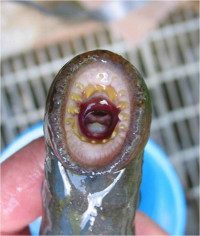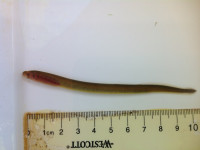Depending on how you feel about a snake-like fish with a suckermouth full of teeth that might drink blood from other fish, the following news might make you squirm: There are likely more species of lampreys in California rivers than we knew.
A recent study, co-funded by California Sea Grant and the California Department of Water Resources, discovered two potential new types of this ancient and often parasitic fish in northern and central California rivers. Once confirmed, it will bring up the number of lamprey species in the state to “probably at least ten,” says Grace Auringer, a doctoral candidate at the Genomic Variation Laboratory at the University of California, Davis, who led the investigation as a California Sea Grant Graduate Research Fellow.
The discovery surprised Auringer. “People have been paying attention to these rivers for a long time, and we hadn't even heard rumors that there were different types of lamprey there,” she says. The findings were recently published in the North American Journal of Fisheries Management.
An Evolutionary Marvel and Culinary Delicacy
Fish that looked much like today’s lampreys already swam in Earth’s waters around 450 million years ago, before dinosaurs started roaming our planet. Lampreys have cartilage instead of bones and don’t possess jaws — those evolved only later.

Instead, they sport a round, suction cup mouth ringed with teeth that they use to pull themselves up steep riverbeds, but also to latch onto other fish as parasites. Shaped like an eel and about two feet long, lampreys swim by undulating their slender bodies to create zones of low pressure ahead of them. This pulls them forward, while most other animals push water away behind the body as they swim. Studies have shown that the lamprey’s unusual mode of locomotion is particularly energy-efficient.
These fish still live in waters all over North America and Europe and their fatty meat have long made them a delicacy in many regions. (King Henry I of England is said to have died from overindulging in lamprey dishes in the 12th century.) In California, Indigenous people traditionally harvest lampreys to eat fresh or dry.
Unraveling Lamprey Mysteries in California Waters
But in recent decades, lamprey numbers in the state have declined dramatically, although nobody knows by how much. “There are many knowledge gaps about lampreys in California,” says Auringer. “This includes that we don’t know the distribution of different lamprey species in the state.”

Auringer set out to change this. Many lamprey species are anadromous, that is, they migrate to the ocean as young adults and then return to the rivers to spawn, much like salmon. The lamprey larvae that hatch from the spawned eggs spend up to nine years buried in sandy river beds before they transform, in a butterfly-style metamorphosis, into their adult form and repeat the journey to the sea.
Auringer sampled 87 larvae and lampreys that were collected as part of fish monitoring programs at 19 sites across the San Francisco Estuary and the Sacramento, San Joaquin and Klamath river basins in northern and central California. She sequenced specific genes in their mitochondria, the component that provides energy in human and animal cells.
Auringer detected two populations — one each in the Napa River and Alameda Creek — that stood out genetically and had not been described before. “They are very genetically different from any lamprey that has ever been collected from anywhere,” she says. The two new populations will still need to be studied morphologically before they can be formally declared as new species.
Lamprey Conservation Efforts Intensify Amid Habitat Loss
The discovery was “exciting,” says Auringer — but also important for conservation. “There's a lot of effort to conserve biodiversity in California, but if we don't understand what biodiversity is present, it's impossible to do.”

Habitat destruction and global warming have likely contributed to the lamprey’s decline. Experts also suspect that the many dams that regulate the flow of water in the state are to blame. “California is one of the most hydrologically altered regions in the world”, Auringer and her co-authors write in the new paper. “Currently, impassable dams block 72% of upstream historical habitat from access by anadromous forms of returning lamprey.”
Over the last 15 years, tribes and conservationists have worked to get more lampreys back to their historical spawning grounds by building tubes and dams that allow lampreys to pass over dams, or by driving adult lampreys on trucks past these obstacles. But “we're only scratching the surface in terms of conservation,” says Auringer. “The lamprey lineage is one of those underappreciated and underrecognized sectors of biodiversity that are still very important, also because of their ecological role.”
Lampreys provide many benefits to freshwater ecosystems. The larvae are filter feeders that eat organic detritus and microorganisms, keeping river waters clean. As adults, pairs of male and female lampreys build nests in the river gravel before spawning by picking up rocks with their suction-cup mouths and moving them around. This helps wash silt from the stream bottom and makes it usable for other fish, such as salmon, to breed.
Having spawning just once, lampreys die. Insects and other organisms feed on their bodies before they, in turn, become food for other species.
Exploring Public Attitudes towards the Controversial Fish
During the next stage of her dissertation, Auringer plans to study how genes help shape the lampreys’ migratory behavior and parasitism (not all California lamprey species prey on other fish). She also intends to explore public attitudes towards lampreys. The fish is controversial, Auringer knows. A Michigan newspaper is said to have once described it as a “blood-thirsty” creature that looks like a “piece of garden hose which was left out in the yard all winter.”
Auringer, by contrast, cheers for these ancient fish species. “As soon as I was introduced to the project, I fell in love with lampreys,” she says. “I think they’re cute and extremely interesting.” She particularly enjoys watching lampreys use the sucking force of their peculiar mouths to climb waterfalls. “They fling their body up, then latch on again. It’s impressive. I’m a superfan.”
About California Sea Grant
NOAA’s California Sea Grant College Program funds marine research, education and outreach throughout California. Headquartered at Scripps Institution of Oceanography at the University of California San Diego, California Sea Grant is one of 34 Sea Grant programs in the National Oceanic and Atmospheric Administration (NOAA), U.S. Department of Commerce.